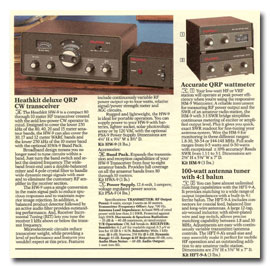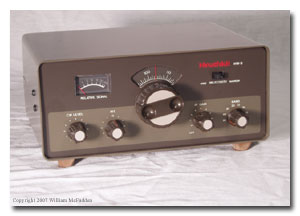
by William Eric McFadden
From the manual:
-
The Heathkit Model HW-9 Deluxe QRP CW Transceiver is a compact 80-through 10-meter HF transceiver designed with the avid low-power CW operator in mind. It covers the lower 250 kHz of the 80, 40, 20, and 15-meter amateur bands. When you install the Model HWA-9 Accessory Band Pack, the transceiver also covers the 30, 17, and 12-meter WARC bands and the lower 250 kHz of the 10-meter band. Broadband circuits eliminate the need to tune circuits within a band. Just turn the Band switch and select the desired frequency.The design of the wide-band front-end stages eliminates the need for the customary RF amplifier in the receiver section. This results in a receiver that can properly handle incoming signals with a wide dynamic range. Also, only one frequency conversion is used in the main signal path of the receiver section. This is done to reduce spurious responses (birdies) and to maintain high image rejection.Power for this Transceiver can be furnished by a power supply, such as the Heathkit Model PSA-9 Power Supply, or directly from any regulated 12.6 VDC source that can supply at least 1 ampere.To align this Transceiver, you should have a VTVM (vacuum-tube voltmeter) or VOM (volt-ohmmeter), a frequency counter capable of measuring frequencies accurately up to at least 10 MHz, and a 50-ohm resistive dummy load.The following features are also included in your Transceiver:
- Solid-state transmit/receive switching that permits full break-in operation.
- Continuously variable RF power output.
- Receiver incremental tuning (RIT).
- An audio-active filter with selectable wide or narrow selectivity.
- A front panel meter that indicates signal strength in receive and relative power in transmit.
This Transceiver is a handy addition to any ham shack for avid QRP operators, newcomers, or old timers alike.Specifications: General Frequency Readout Analog dial. Readout Accuracy 5 kHz divisions. VFO Frequency Tuning Bandwidth 250 kHz minimum. Tuning Backlash Less than 100 Hz. Frequency Tuning Rate Approximately 40 kHz per knob revolution. Frequency Coverage 3.5 MHz - 3.75 MHz.
7.0 MHz - 7.25 MHz.
*10.0 MHz - 10.25 MHz.
14.0 MHz - 14.25 MHz.
*18.0 MHz - 18.25 MHz.
21.0 - 21.25 MHz.
*24.750 - 25.0 MHz.
*28.0 MHz - 28.25 MHz.Frequency Stability Typically less than 500 Hz pr hour after a 30-minute warm-up. Typically less than 150 Hz pr 30 minutes after a 90-minute warm-up. Power Requirements 11 - 16 VDC at 1 ampere (12.6 V specified). Operating Temperature Range 0° to 40° C. All specifications referenced to 12.6 VDC at 25° C. Front Panel Meter Relative S-units in receive, relative power in trasmit. Modes - Transmit/receive CW only. Front Panel Controls AF Gain with power off/on, Band switch, RIT control, Audio Filter wide/narrow, CW Level (drive), Main Tuning. Rear Panel Connections DC Power, Speaker, Headphones, Antenna, Key, Ground. Optional Accessories Model PSA-9 Accessory Power Supply
Model HWA-9 Accessory Band PackDimensions 4-1/4" H x 9-1/4" W x 8-1/2" D (10.8 x 23.5 x 21.6 cm). Weight 4.7 lbs (2.1 kg). * WARC bands are part of the Model HWA-9 Accessory Receiver Sensitivity Less than .5 uV for 10 dB S+N/N. Less than .2 uV for readable signal. Selectivity, CW Audio Filter Narrow - 250 Hz maximum at 6 dB.
Wide - 1 kHz maximum at 6 dB.Passband Center Frequency 700 Hz (approximate). Audio Output 1 watt into 8-ohm load. Dynamic Range 85 dB, measured in the Narrow filter mode. Image Rejection 60 dB minimum. IF Rejection 60 dB minimum. Internally Generated In-Band Spurious Typically below 2 uV except at 3.695, 7.166, 10.150, 14.041, 14.083, 21.195, 21.249, 28.089, and 28.093 MHz. Audio Hum and Noise At least 60 dB below maximum output RIT ± 1 kHz Transmitter RF Output Power CW, 4 watts on all bands except 3 watts on 10 meters. Transmitter Frequency Offset 700 Hz higher on all bands (approximate). Antenna Load Impedence At least 90% of rated power with less than 2:1 SWR. Protected against high SWR. Harmonic Radiation -35 dB minimum, at rated output. Spurious Radiation -40 dB minimum, at rated output. T/R Operation CW: Full break-in. CW Sidetone 700 Hz (approximate) to speaker or headphones. Output level internally adjustable.
The HW-9 was the third and final QRP transceiver offered by Heathkit. It replaced the HW-8 and was first offered in 1984 and remained available until the end of amateur radio kit production by Heathkit in 1991. The HW-9 was the same size as the HW-7 and HW-8 but inside the chassis was a complete redesign. Whereas the earlier rigs featured direct-conversion receivers, the HW-9 featured a super-heterodyne receiver with balanced mixer and broadband design. The basic HW-9 covered the lower 250 kHz of the 80, 40, 20, and 15 meter bands, but an upgrade kit was available to add coverage of the 30, 17, and 12 meter WARC bands and the 10 meter band. On the transmit side, the HW-9 offered full break-in CW (QSK) and output of at least four watts on all bands but 10 meters. The cost of the basic HW-9 (without band-pack) was $249.95.
 I purchased my HW-9 in May, 2007. Unfortunately, the very first time I
hooked it up to a battery to verify operation, I discovered the hard way that the builder
had installed the rear-panel two-pin Molex power connector backwards so that the silk-screened
"+" on the cabinet was actually over the negative terminal. This application of reverse polarity
resulted in a blown fuse on the battery lead, two blown final transistors, and a shorted zener
diode. While repairing the rig, I also corrected the the power socket orientation so this
problem won't happen again.
I purchased my HW-9 in May, 2007. Unfortunately, the very first time I
hooked it up to a battery to verify operation, I discovered the hard way that the builder
had installed the rear-panel two-pin Molex power connector backwards so that the silk-screened
"+" on the cabinet was actually over the negative terminal. This application of reverse polarity
resulted in a blown fuse on the battery lead, two blown final transistors, and a shorted zener
diode. While repairing the rig, I also corrected the the power socket orientation so this
problem won't happen again.
A previous owner had installed a commercial open-frame power supply in a Heathkit SP-99 speaker cabinet. (The SP-99 was designed for use with the HW-99 Novice transceiver. The HW-99 was slightly larger than the HW-9 but had the same color-scheme and looked similar; the SP-99 is slightly taller than the HW-9.) I also have an Optimus XT 3 speaker that I use with the HW-9. The XT 3 just about the perfect size to sit next to the HW-9, and the woodgrain sides and black grill look very good are a very nice match to the HW-9's two-tone brown coloring.
I have the matching HM-9 SWR Bridge/Power Meter. I am watching for the matching HFT-9 Antenna Tuner, just to complete the set.
I'm not entirely satisfied with the receiver in my HW-9--strong signals outside the audio passband cause very bad AGC pumping. In the HW-8 Handbook Cam Hartford, N6GA, found that the IF filter supplied by Heathkit has a bandwidth of about 3kHz. He replaced the IF filter with a 450Hz unit he built himself. (See page 90 in HW-8 Handbook, Second Edition.)
An extremely useful reference on the HW-9 is Michael Bryce's HW-8 Handbook, Second Edition. This book provides circuit descriptions, schematics, board layouts, alignment instructions, Heathkit service bulletins, and modifications for the HW-7, HW-8, and HW-9. It is available at Michael Bryce's The Heathkit Shop, at Kanga, USA, and at QRP ARCI. The older, First Edition, HW-8 Handbook has modifications for the HW-7, HW-8, and HW-9 but lacks the other valuable content.
Advertisements
HW-9 Links
- HW-9 at rigpix.com
- Heathkit Classic QRP Rigs at ARRL
- Heathkit HW-7/8/9 Information Page by KK4KF, including service bulletins and mods
- K8YTO's Heathkit QRP Modifications in Excel spreadsheet format
- The following articles are available to ARRL members; search the QST Archives:
- HW-9 ARRL Product Review (July, 1985 QST)
- Improving the HW-9 Transceiver, by Chuck Hutchinson, K8CH (April, 1988 QST)
- Improving the HW-9 Transceiver, by Zack Lau, KH6CP(April, 1988 QST)
- Technical Correspondance: HW-9 Tips, by Larry East, W1HUE (October, 1988 QST)
- Feedback: HW-9 Tips (December, 1988 QST)
- Hints and Kinks: An AGC-Threshold Control for the Heath HW-9,
by Jim Douglas, NI2F (March, 1990 QST) - Hints and Kinks: A Narrow IF Filter for the Heath HW-9,
by Thomas Niedermayer, NK6E (June, 1990 QST)
Attribution: "HW-9 & Accessories" ad found on eBay auction of HW-9, HM-9, and HFT-9A.
